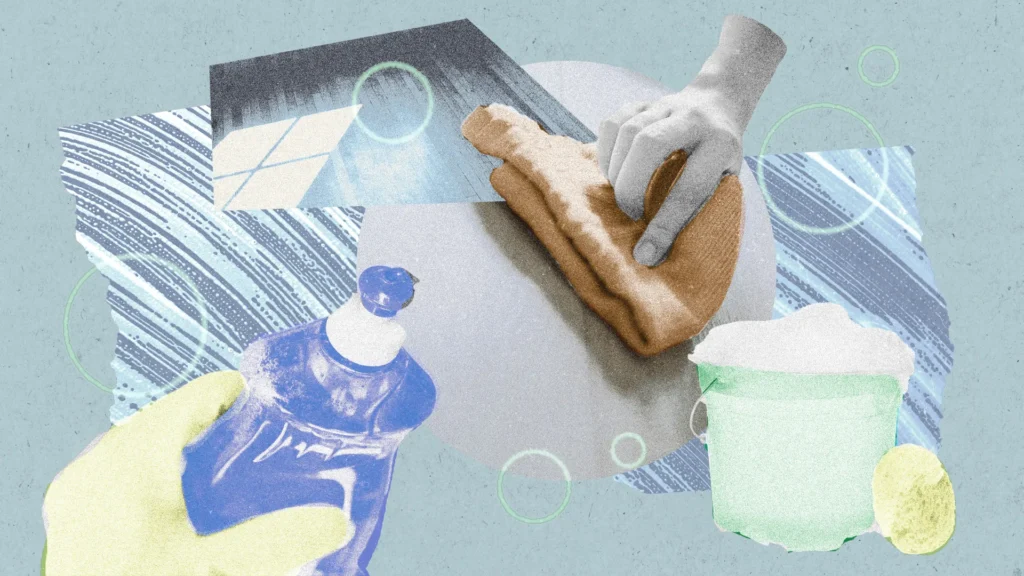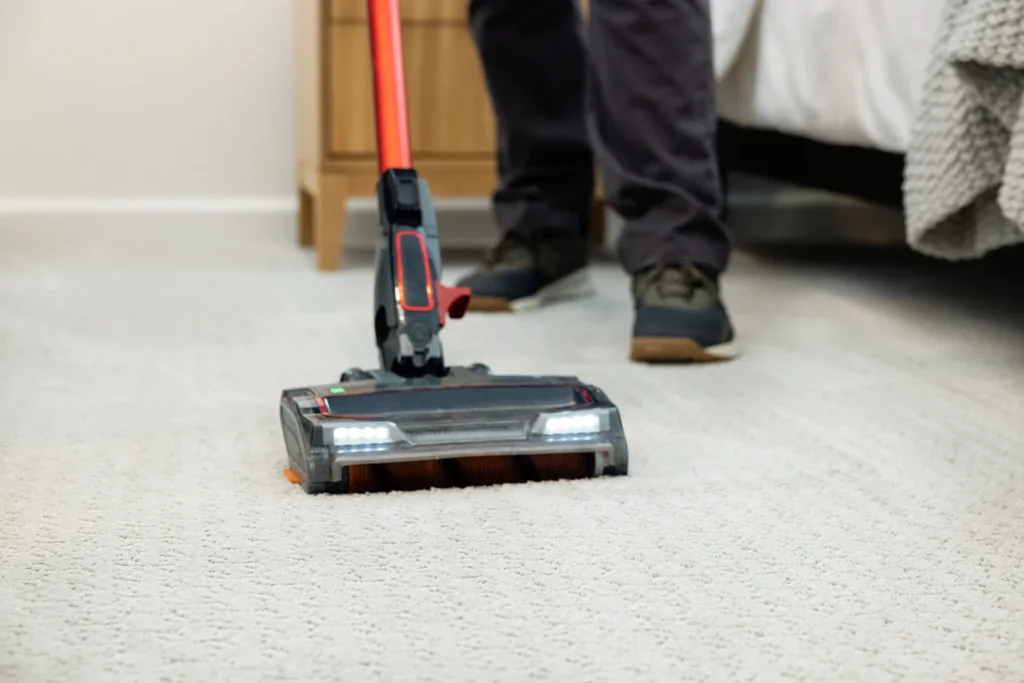
Caring for
Your Floor
Every floor type is different. From installation to care and maintenance, it is important to review the maintenance and cleaning and care guidelines specified for your product to ensure longevity. Many warranties also indicate that regular cleaning is required for the warranty to stay valid. There are many different ways to keep your flooring clean, depending on flooring type and application. Below are some tips and tricks for care and maintenance on different flooring types.
Laminate
Overall, sweeping and vacuuming and occasionally moping works well to keep your flooring looking good, but additional care and maintenance is already a good idea.
- Read your guidelines: Installation, care and maintenance guidelines vary from vendor to vendor so it is important to take time to read through the specifics for you flooring to find the best way to care for it.
- Don’t let stains sit: It is important to clean spills quickly. Even with water-resistant products, the faster you clean spill, the better for your flooring. Using a microfiber cloth or sponge to absorb spills is a great approach. Again, read through your warranty info, most will outline how long water can sit on the floor or within what time-frame a spill needs to be addressed to keep your warranty intact.
- Don’t use abrasive tools: Recent updates in flooring technology has made most laminate flooring materials are made to be scratch-resistant, but using abrasive products like steel wool, or harsh chemicals can cause damage to your floors. Using a soft-bristled broom or dust mop works great for regularly cleaning.
- Mopping: Most laminate is not water resistant, so exposing it to too much moisture can cause issues in the long-run. It is recommended to mop every two months. Use a damp microfiber mop or if you are using a traditional mop, make sure you wring out as much water as possible You want avoid using too much water on your laminate floor to eliminate potential for damage.
- Cleaning products: It is best to use product specifically labeled safe for laminate flooring. Using oil-based cleaning products can potentially leave streaks or residue on the protective sealant of your flooring. If you do find a suitable laminate floor cleaner, make sure to apply it to the microfiber cloth or mop as opposed to applying directly on the floor. Never wax or polish your laminate.
- Protect the surface: Care and maintenance goes beyond just keeping it clean. You must also take steps to protect your flooring from scratches. Use furniture pads on the bottom of your furniture and chairs to avoid scraping your flooring.
Carpet
- Preventative Maintenance: Carpet stains that have settled can be difficult to clean. It is best to try to prevent stains from happened. Of course, this is not an easy task, but focusing on high traffic areas like entryways, doorways or hallways can be a great first step. Adding area rugs or walk-off mats can help to reduce the amount of dirt and potential for difficult stains.
- Spot Cleaning & Spill Removal: Addressing any stains or spill quickly can help to keep them from settling in. Blot stains and spills with a clean cloth, starting from the edge of the stain and working your way in. This can help keep the stain for spreading. Find products that are specially formulated for rugs and carpet and follow the instructions.
- Vacuum regularly: Vacuuming regularly to help keep your carpet clean is another great way to avoid large or settled in stains. Focus on high traffic areas at least once a week, make sure not to forget to clean under furniture to avoid dust accumulation. Think about investing in a high-end vacuum to get the best out of your cleaning routine.
- Steam cleaning and Deep cleaning: Check your warranty guidelines. Many warranties outline how often and what kind of professionally cleaning is required to maintain your warranty coverage. Hot water extraction or steam cleaning are great options for deeper or more stubborn stains. They work to extract oils and particles from deep within your carpet, leaving you with an overall cleaner, and more sanitary floor.
LVP Flooring Do’s & Don’ts
Do
- Clean floor regularly with a solution approved for vinyl flooring. P/H neutral cleaning products are best, but warm soapy water and a soft mop are a great a option as well for regular cleaning.
- Spot test before applying any kind of cleaning solutions to your flooring
- Focus on high traffic areas. Use rugs or mats to help prevent dirt and other debris from building up on your flooring.
- Clean spills immediately. Don’t let spills sit on your flooring for too long. It is best to clean as soon as possible.
- Use furniture pads to avoid scratches. These are great for underneath chairs as well.
Don’t
- Don’t use any cleaning products containing wax or oil. The resident from these cleaning agents can leave a film on the top layer of your flooring.
- Do not use products designed for wood flooring.
- Avoid using DIY cleaning solutions with vinegar. The acidity can cause damage to your flooring’s finish.
- Avoid wet-moping and steam mopping your floor. Vinyl plank is pretty simple to keep clean. There is no need to make it too complicated.
- Try not walk on your floors in cleats, high heels or other sports shoes. Those vinyl plank is scratch resistant, it is subject to denting.
- Do not buff your floors with a nigh speed buffer.
Engineered Hardwood
- Sweep and Vacuum Regularly: One of the easiest and more effective way to keep your hardwood clean, is to simply sweep and vacuum regularly. Keep dirt from piling up on your floors and creating a bigger problem later. A soft-bristled brush and a vacuum with a hardsurface attachment are both great options. Done regularly, this can you avoid scratches caused by dirt particles on your floor.
- Use a Microfiber Mop: Microfiber mops are soft and a great option for engineered hardwood. They are gentle on the floor’s finish and provide great cleaning power. You can dampen the mop slightly, but try to avoid using too much water, that could damage your flooring.
- Use the right products: look for a PH-balanced cleaning product specifically made for hardwood. You can also use a few drops of mild dish soap with warm water.
- Avoid Excess Moisture: Engineered hard-word is not water-proof. Excess moisture can cause damage to your floors. Avoid mopping with too much water, applying cleaning agents directly to floors, and letting spills sit on your flooring for too long.
Carpet Tile
- Vacuum Regularly: Regular cleaning is essential in the upkeep of any flooring, carpet tile included. Vacuuming removes dirt and grim that may cause damage to flooring if left behind. Regular vacuuming can also help prevent the carpet fibers from flattening. Make sure to read through the warranty guidelines to find the specific cleaning requirements for your specific product.
- Clean Spill Immediately: It is very important to clean any spills up as soon as possible. Blot the spills with a clean cloth or paper towel. Its best to start from the outside and work your way in. Make sure to check what kind of cleaning agent is suggested by the manufacturer to ensure you do not damage your carpet tile with harsh chemicals.
- Schedule Regular Cleaning: Professional cleaning is often-times required by the flooring warranty. Check the guidelines for the instructions on how often regularly cleaning is required. This may vary based on the amount of foot traffic.
- Replace Damaged Tile: One of the great benefits of carpet tile is that damaged pieces can be easily replaced when needed. It is best to keep a few extra boxes of your project for any repairs or replacements that may be needed down the line.
VCT Tile
- Daily Cleaning: VCT is relatively easy to keep clean. Sweep, dust mop or vacuum regularly to remove dirt and debris. You may also use entry mats in entry ways or under furniture to help keep dust away. It is important to clean any spills as soon as possible as well.
- Damp Mopping: Avoid harsh chemical cleaners. Use a neutral pH cleaner and a damp mop to clean your tile. It is important to avoid using excess water on the mop as this could lead to damage of your flooring.
- Regular Maintenance: Using a machine to scrub the floors regularly and applying a fresh topcoat can help reduce the need for frequent stripping of the tile.
- Sealing: VCT tile requires sealing within a few days of installation and then once or twice annually depending on the amount of foot traffic.
Laminate
Laminate Flooring 101: The Do’s and Don’ts for Keeping Them Clean
Prevent wear and tear—on new floors and old—with these DIY cleaning methods
Carpet
Carpet Preventative Maintenance | Shaw Floors
Easy, proactive steps will keep your carpet looking good over time. Placing walk-off mats outside all entrances will help absorb
Carpet Cleaning Guide | Flooring Fundamentals | Shaw Floors
Carpeting is a popular flooring choice in many homes due to its comfort and aesthetics. To keep your carpet looking
LVP
Vinyl Flooring Care and Maintenance | Shaw Floors
Congratulations on your new luxury vinyl floor! Protect your investment with these simple care tips. Immediately following installation During the
How to Clean Vinyl Plank Flooring: Care & Maintenance Guide
Care & Maintenance is key to your Vinyl Plank floors’ lifetime. Having a consistent maintenance routine and the proper protection helps
LVP Flooring Care & Cleaning | Lions Floor
Follow these steps to help minimize maintenance and maintain the beauty of your vinyl floors.
Hardwood
How to Clean Hardwood Floors Like a Pro in 6 Simple Steps | Architectural Digest
Experts offer cleaning tips to ensure wood floors look like new and last for decades Once you decide to replace
How to Clean Engineered Hardwood Floors
Like any wood flooring, engineered hardwoods are an investment. So you want to take care of that high-quality investment. That
Moisture
Prevent Moisture Damage: Control Concrete Floor Moisture
Moisture coming through concrete floors is a common yet serious issue that can lead to costly damage, including warped flooring,
How to Fix and Prevent Subfloor Moisture Problems – Bessemeter
Imagine this: you install a gorgeous hardwood floor. Your client is so happy with the new flooring, and so are
Get in
touch
We’d love to hear from you! Whether you have a question, feedback, or just want to say hello, feel free to reach out. Your thoughts are important to us, and we’re here to assist you.
Connect with us today and let’s start a conversation!
















